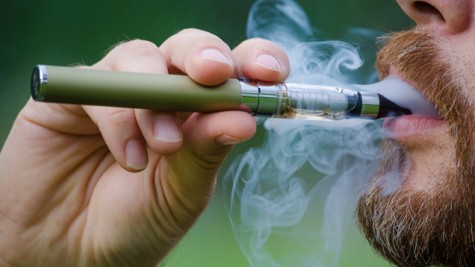Addicted to the clouds
The times of greasy cigarette smoke and foul smelling tobacco in the air nearly are over. Nowadays, some smokers are choosing to exhale milky clouds of delightful scents – from fruity pebbles or strawberry shortcake, all while they achieve a similar “buzz.” Vaporizing or “vaping” is not necessarily a new fad, but has only recently become much more popular than in the past. While the health concerns regarding nicotine are still up for debate, it is safe to say that vaporizing is a much safer and cleaner alternative to cigarette smoking.
Initially invented to help smokers quit their addictions, Hon Lik invented the first electronic cigarette or “e-cig” after his father had passed away from lung cancer in 2003. The 52 year old inventor and heavy smoker had designed the e-cig to look and feel just like a regular cigarette, without the toxic tobacco and additives. The only active ingredient was 6mg of nicotine, enough to give users the exact same buzz as a cigarette. Unlike cigarettes which transfer the nicotine via smoke, e-cigs infused the nicotine into water vapor- which inventors and marketers later began to flavorize. Flavors range from your basic fruits, such as watermelon, blueberry, strawberry kiwi, and pomegranate, to more unique flavors such as cola, cotton candy, or even fruit loops. More creative, exotic flavors exist, including unicorn milk. When it comes to flavors vape juice companies have really overdone it. Flavors also come with different nicotine levels, ranging from 0mg, 3mg, 6mg, and 12mg.
Thus was the beginning of the vaporizer. The initial e-cig technology evolved into a full setup with a rechargeable battery, larger heating coils, and a bigger tank that can be could be refilled- instead of having to be thrown out and repurchased like the early e-cigs. As the market for vaporizers grew, so did the selection of flavors and other accessories. No longer are these devices used to cure addictions, but rather achieve a new kind of high.
Although nicotine has no psychoactive ingredients, it does trigger huge releases of dopamine in the brain’s pleasure center, thus making it highly addictive- in some cases even more addictive than heroin. Other than its highly addictive properties, nicotine has actually never been proven to show an increase in heart disease, tumors, or other respiratory illness. The chemical tends to get a bad rap because of its association with tobacco, but it is the harmful additives in cigarettes, not the nicotine itself, that is cause for ailment- the nicotine just makes cigarettes addictive.
As far as the law is concerned, however, e-cigs and vaporizers are just as bad as the cigarettes they are trying to replace. There was a short timespan where government policy had nothing to say about these new devices, but policymakers soon caught up and categorized them the exact same as any other tobacco product. That means they are unlawful to use inside, and users must be 18 years or older to purchase vapes as well as any of their accessories. Even the fllavor juice is required to have warnings of adverse health effects the same way cigarettes do, even though they contain no tobacco.
Although there may be slight disconnect between policy and reality, the truth is there is simply not enough experimentation and backtesting to prove whether or not nicotine is harmful. The government is just staying on the safe side, essentially saying “proceed with caution.”

